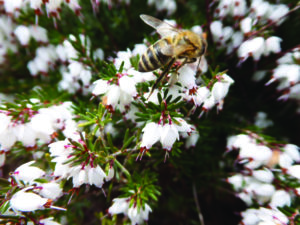Connecting with nature is one benign, widely practiced, and evidently very effective way of coping with anxiety. In Herman Melville’s Moby-Dick, Ishmael, instead of “stepping into the street, and methodically knocking people’s hats off,” went to sea. That’s a tempting invitation for us coastal types, but simpler alternatives happily abound on a rural peninsula thrust into the North Atlantic Ocean. Beekeeping is one on them.
Looking after bees allows for being outside, keeping one’s social distance, and asking such questions as “I wonder what my bees are doing?” — always a good remedy for insomnia. But we’re at a season when the question is much more engaging than it sounds, and it helps to take us closer to the calming effects of nature.

Research continues to show how closely honey bee behavior is tied to the local environment. Seasonal and even daily variations in the weather profoundly affect colony activities. With the earliest pollen and nectar now copiously available from willow and red maple, field bees burst from colonies to make the most of this narrow window of resource abundance and return with honey stomachs bulging with nectar and hind legs laden with pollen.
Willow provides bright yellow, and red maple orange pollen grains; the former are extremely nutritious, having an ideal complement of protein-forming amino acids for the growth of immature bees.
The field bees’ frantic delivery and processing of new nectar in the hive stimulates the queen bee to lay more eggs, which means more larval bee mouths to feed. Bee larvae and pupae (known collectively as “brood”) in turn emit complex volatile compounds, pheromones, that tell field bees to forage more intensively whenever warm and dry weather permits bee flight. Egg-laying by the queen in spring is so tied to nectar flows that it occurs in fits and starts depending on daily flying conditions. Continuous egg-laying and colony growth doesn’t hit full stride until more consistently warm weather in May, when the hive’s population rapidly grows toward a peak of some 60,000 bees.
Spring colony growth now is fueled not only by the bees’ hand-to-mouth field work, and by what’s left of honey and pollen collected last summer, but also by “fat bodies.” That is, fat and protein reserves stored in the abdomens of the overwintered bees themselves. After squirreling away these rich reserves in their bodies all winter, and consuming only honey, the long-lived winter bees kick-start spring colony growth by feeding their “fat bodies” to the new crop of larvae. The winter bees’ self-sacrifice involves leaving the hive during sometimes dreary and cold spring days and working themselves to death foraging fresh nectar, pollen, and water for the growing brood.
A lot of what’s going on with bees in any season can be surmised by informed and careful observations at the hive entrance. In fact, there’s a whole book about this with the fitting title At the Hive Entrance by H. Storch (free at archive.org). A hive of honey bees is not actually required for this kind of contemplation during anxious times. One can watch insects of all kinds on spring flowers, or waves cresting over the bars at Newcomb Hollow, or the progression of plant growth in our woods, wetlands, and gardens — they all beat knocking people’s hats off.



